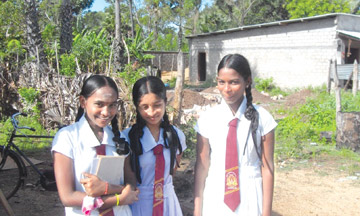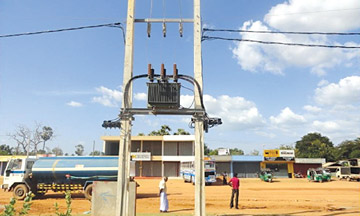|
Major development projects under way:
Mullaitivu, a model city soon
By P. Krishnaswamy

The standard of education has improved |

Asphalted roads |

Electrification in Mullaitivu |

New DDHS Office building |
 |
| Ground nut
cultivation |
 |
| New Circuit
Bungalow at Selvapuram |
The Mullaitivu district that bore the brunt of the LTTE's terrorist
activities for over three decades will soon be transformed as a model
region with modern townships, extensive infrastructure, industrial
complexes, tourist centres and more livelihood facilities for the local
population who mostly comprise agricultural and fisher families.
Under the LTTE's terrorist regime, the district remained a largely
mine-infested region, inaccessible to the Government's development
programs and experiencing constant exodus and displacement of the
people.
A team of experts from the Moratuwa University is working on town
planning projects to transform Pudukudiyiruppu, Oddusuddan and
Mullaitivu as advanced and modern townships with more educational,
health care and residential facilities. It is anticipated that these
would become better townships than even Jaffna and Vavuniya, according
to authoritative Government sources.
The Urban Development Authority (UDA) is also working on the modern
township projects. Tourism centres, adventure parks and mini-golf
courses will feature under the town planning.
The district was the theatre of the final military onslaught to wipe
out terrorism from the face of the country and, consequently, the entire
population who were displaced and remained in welfare centres in Menik
Farm and elsewhere have now been resettled in their own villages. The
welfare centre has already been closed down.
A total of 37,750 families consisting of 120,068 persons have been
resettled in Thunukkai, Manthai East, Oddusuddan, Maritimpattu,
Pudukudiyiruppu and Welioya, ending displacements, according to District
Secretariat sources.
Electrification projects are under implementation and 100 percent
electrification to the entire district is anticipated, to be achieved
next year with the completion of these projects. As at July 31, 2012,
26,802 fully damaged houses have been reconstructed and an additional
12,558 new houses have been put up.
The number of new houses needed as of now is 14,244 and this housing
requirement for the displaced families is also expected to be completed
in the near future with the construction process already under way.
Houses repaired
Over 6,072 partly damaged houses have been repaired while the
requests for repairs to 3,972 houses has been partly responded to; only
2,100 houses still remain to be repaired, according to figures furnished
at the District Development Meeting at the Mullaitivu Secretariat on
September 28.
The last batches of displaced families that recently returned from
the Menik Farm welfare centre comprised 154 families who lived in
Koppapilawu before their displacement. On account of the Strategic
Headquarters of the Security Forces being located in Koppapilawu,
alternative arrangements having to be made to accommodate the families,
a plan was formulated to build a model village. The construction of the
model village with independent housing units, wells, electricity, road
network, schools, health care and other facilities is already under way.
The village is being constructed in an extent of 80 acres and is in
close proximity to the area where these people lived. Each family will
be allotted 40 perches of land with the house. Putting up temporary
shelters for these families has almost been completed by the Security
Forces who are also engaged in helping the local communities in
renovating houses, rehabilitating roads, clearing shrub jungle, cleaning
the surroundings and organising community events in a spirit of goodwill
and brotherhood, the sources said.
The housing project and other welfare projects for the resettled
families were launched by Parliamentarian Namal Rajapaksa.
The Ministry of Economic Development, under its Irrigation
Development Works program for increasing agricultural productivity,
allocated a total amount of Rs. 2,022 million for the project.
Irrigable land of 20,589 acres and 17 tanks are covered under this
project, benefiting nearly 9,000 farmers. About 1,215 abandoned
agricultural land was also reclaimed under this project.
Under the programs, which came into implementation after the
elimination of LTTE terrorism in May 2009, a variety of agricultural
equipment including 206 two-wheel tractors, 144 four- wheel tractors and
3,639 water pumps have been distributed among the farmers.
Seed material supplied include 2,723 tonnes of paddy, 0.220 tonnes of
ground nuts, 0.060 tonnes of black gram, 0.030 tonnes of green gram,
0.040 tonnes of cowpea, 0.050 tonnes of red onions, 0.004 tonnes of
maize and 0.002 tonnes of gingelly.
This is in addition to highly subsidised fertilisers and concessional
services, where necessary, for ploughing the lands for cultivation. A
total of 181 sprayers, 176 rolls of barbed wire and 1500 organic tools
were also supplied to the farmers.
Community enhancement
Under the Conflict Affected Region Emergency Project, 10 tanks,
including four major tanks - Vavunikkulam Tank, Maruthamkulam Tank,
Kalvilankulam Tank and Kollavilankulam Tank - have been rehabilitated.
The Thenniyankulam project was implemented under the Pro-poor
Economic Advancement and Community Enhancement Project. The balance
amount required for the tank rehabilitation work is estimated at Rs. 900
million and the Muthuiyankulam Tank will also be rehabilitated under
future programs. The extent of irrigable land under the project will be
6,112 acres and the number of farmer families benefiting is 3,330. A sum
of Rs. 1,800 million is required for rehabilitating the Kanukkery Tank
and the number of families benefiting is 320 and the extent of land
coming under irrigation is 1,813 acres.
A total allocation of Rs. 23,450.75 million was provided for
improvements to the 224.67 km road network within the district which
include construction of new roads, renovation and rehabilitation. All
these roads are asphalted.
Seven highways, including the Kandy - Jaffna A-09 highway and the
Paranthan-Karachchi-Mullaitivu A-035 highway, have been developed by the
Road Development Authority (RDA) under fund allocations of the Ministry
of Economic Development.
The Ministries of Economic Development and Local Government and the
Provincial Council rehabilitated 12 roads extending 65.5 Km, at a cost
of Rs. 1,424 million. Fifty houses were constructed under the Kokkilai
Housing Project and 500 houses were constructed under the Welioya
Housing Project funded by the Ministry of Resettlement.
Paddy cultivation
The cultivation of paddy, highland crops, vegetables and fruits that
had diminished to the lowest levels prior to the first quarter of 2009,
during LTTE terrorism, improved considerably in the post-2009 period. Up
to now, in the current year, paddy cultivation has been recorded at
17,769 tonnes, highland crops at 7,692 tonnes, vegetable cultivation at
2,123 tonnes and fruit cultivation at 565 tonnes.
The targeted production for 2016 is 82,600 tonnes of paddy, 22,000
tonnes of other field crops, 56,590 tonnes of highland crops and 6,650
tonnes of ground nuts. It is projected that this increased level of
cultivation will contribute to four percent of GDP in 2016.
The total number of schools in the Mullaitivu district is 115 with a
total student population of 24,037 and 1,508 teachers. The improvement
of educational standards is one of the main focuses of the Government.
Under the Mahinda Chinthana vision of developing 1,000 secondary schools
and 5,000 primary schools throughout the country, six core schools and
22 feeder schools in the Thunukkai Educational Zone and four core
schools and nine feeder schools in the Mullaitivu Educational Zone are
to be developed at an expenditure of five million rupees and Rs. 4.5
million respectively (total Rs. 9.5 million). The total expenditure
under various education-related programs for the district during the
years 2009 - 2012 is Rs.487.22 million.
The achievements targeted by the year 2016 in the field of education
are: achievement of GCE(O/L) and GCE(A/L) by 75 percent, increase in A/L
Science education by 70 percent, building social harmony, reconciliation
through co-curricular activities and fulfilling the requirements of
science labs, libraries and ICT rooms in all I AB and Type II Schools.
The nearly 15,000 population living along the coastal belt extending
70 Km are blessed with a fertile fishing zone. The Ministry of Fisheries
and Aquatic Resources Development and the provincial administration have
implemented many far-reaching programs for the social and economic
welfare of the fishing communities. The fish production that was
1,379.55 tonnes in 2010 increased threefold to 4,361.73 tonnes in 2011
and a considerable increase has already been recorded this year. It is
projected that the fish production will increase several-fold in the
future.
The line ministry distributed fishing nets, mechanised boats,
non-mechanised boats, and other fishing gear to the fisher families who
had lost everything during the long drawn out terrorism.
Welfare projects
The Ministry had also introduced several welfare projects, including
insurance schemes, pension schemes and scholarship schemes for
schoolgoing children of the fisher families.
All hospitals are functional with a 75 percent presence of doctors
and 100 percent presence of other staff. Medical equipment was supplied
to the Mullaitivu District General Hospital, the Base Hospital, eight
divisional hospitals, 90 primary medical care units and the chest
clinic.
The newly constructed office of the Regional Director of Health
Services was inaugurated on June 23, 2012 by Parliamentarian Namal
Rajapaksa, Minister Rishad Bathiudeen and Northern Province Governor
Maj. Gen. G.A. Chandrasiri in the presence of dignitaries and senior
government officials. Laying the foundation stone for a surgical ward
also took place.
The Ministry of Public Administration and Home Affairs constructed a
circuit bungalow at Selvapuram at a cost of Rs.58.6 million.
|


